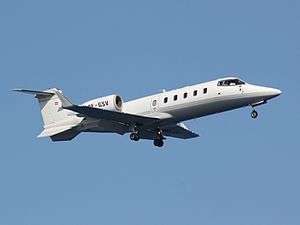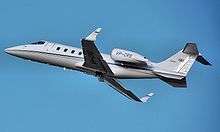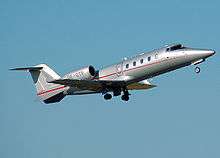Learjet 60
| Learjet 60 | |
|---|---|
 | |
| Role | Business jet |
| Manufacturer | Bombardier Aerospace |
| First flight | 10 October 1990 |
| Introduction | January 1993 |
| Status | In Service |
| Produced | 1991–2012 ("production pause") |
| Number built | 400 as of February 2012[1] |
| Unit cost | |
| Developed from | Learjet 55 |
The Learjet 60 is a mid-size cabin, medium-range business jet aircraft manufactured by Bombardier Aerospace in Wichita, Kansas. Powered by two Pratt & Whitney Canada PW305A engines, it has a range (with 4 passengers and 2 crew) of 2,405 nautical miles (4,454 km) with NBAA 100 nmi (190 km) reserves, ISA.[3] In July 2012 Bombardier Aerospace announced a temporary "production pause" of the latest variant Learjet 60XR to begin in the fourth quarter of 2012.[4][5]
Development

The Learjet 60 is an improved version of the Learjet 55, with a longer fuselage and more powerful turbofan engines. It first flew on 10 October 1990 and received FAA certification in January 1993.[6]
The modifications that converted the Learjet Model 55 into a Model 60 resulted from an aerodynamics improvement program and a need to increase the capacity of the Learjet product line. Several of these modifications were a first for Learjet, including an all-new inboard wing cuff added to the inboard sections of the “Longhorn” wing and an all-new wing-to-body fairing. By increasing the wing chord and the leading edge droop, the wing cuff improved handling during approach and landing, while the wing-to-body fairing reduced the interference drag between the wing and the fuselage. Since the engines were new for this aircraft, a new engine pylon had to be designed.
The lines of the cockpit have not changed but the fuselage was lengthened. In addition, the blend between the fuselage and the empennage was all new. While it appears as if area ruling was the intention of the blending, the blend design was really driven by attaching the original Learjet Model 35 empennage onto the larger Learjet Model 60 fuselage.
The final aerodynamic improvements to the Model 60 included the creation of the distinctive "ogive" winglet trailing edge. This lengthening of the chord near the interface of the winglet and the wing improved the interaction of the wing’s pressure spike with the winglet’s pressure spike. The result was a significant lowering of the drag in this area and a significant improvement of the wing's efficiency. On the prior “Longhorn” wing the interference between the winglet and the wing nearly canceled the effects of the winglet. The single ventral fin was also replaced with two ventral fins that Learjet called "Delta Fins" to improve stall characteristics and promote aerodynamic stability.
The Learjet 60 is notable for its time-to-climb performance, climbing to 41,000 feet (12,497 m) in 18.5 minutes at maximum weight. It also distinguished as the last legacy Learjet, using the wing that designer Bill Lear adapted from the Swiss military aircraft, the FFA P-16. The next-generation Learjet is the Learjet 85 and is an all-new design by Bombardier Aerospace slated for delivery in 2013.[7]
The Learjet 60, while a tremendous performer, also maintains the highest incident/accident rate in its class with most accidents occurring during landing. According to the NTSB most of these failures are caused by pilot-error as the aircraft can be unforgiving.[8]
Production of the Learjet 60 ended in 2007 after 314 aircraft had been built. The Learjet 60XR is the current model in production from Bombardier Aerospace.
Learjet 60XR
Bombardier launched a new variant in 2005 designated the Learjet 60XR and following certification deliveries started in 2007.
Grandfathered on the 1966 Learjet 24 type certificate,[9] it was built until 2013. It features three-rotor disc brakes, good for 450-600 landings, Rockwell Collins Pro Line 21 avionics, upgraded AHRS and FMS, electronic charts, enhanced MFD and optional XM radio weather. Cabin space is better utilized with five floor plans, LED lighting, better insulation and improved cabin management system. The 60XR has the largest Learjet cabin, its cross-section is competitive but its length is 2 to 5 ft (0.61 to 1.52 m) shorter than other mid-size jets like the Hawker 800XP. The small 265 sq ft (24.6 m2) wing evolved from the Learjet 23, with the tip tanks replaced by winglets, and runway requirements are long for the 23,500 lb (10,700 kg) aircraft.[10]
A typically equipped 60XR weighs 940 lb (430 kg) more than the original Model 60, tanks-full payload is 600 lb (270 kg) and four-passenger range is 2,240 nmi (4,150 km). It climbs to FL 410 in 18 min and cruise at 440 kn (810 km/h) TAS with an average fuel burn of 1,300 lb (590 kg)/h. Long-range cruise varies from 387 to 420 kn (717 to 778 km/h) TAS at FL 350-430 and ISA conditions, while normal cruise speed is Mach 0.76 or 436 kn (807 km/h) TAS. The FADEC-controlled 4,600 lbf (20 kN) PW305A turbofans have a 6,000 h TBO and reserves amount to $360 per hour per engine. In September 2018, there were 112 Model 60XRs in service, priced between $2.5 million for a 2007 model to $4.0 million for a 2013 one.[10]
Operators

.jpg)
Civilian
The Learjet 60 is used by private operators, companies and fractional jet operators.
Military and government

- One Learjet 60XR used by Tucumán Government.[11]
- One Learjet 60 used by the "Jefatura Del Estado Mayor"



- One Learjet 60 delivered in April 2005 to replace the lost King Air 200. Used by the Government for VIP transport.[13]

- Two operated by the Department of Civil Aviation Malaysia (DCAM) Flight Calibration Division.

- One Learjet 60 delivered for the Mexican Navy.[14]

- Six Learjet 60 aircraft are operated by the Federal Aviation Administration to carry out airborne accuracy checks of navigational facilities.[15]
Incidents and accidents
- On September 19, 2008, a Learjet 60 crashed while taking off from Columbia Metropolitan Airport in Columbia, South Carolina. Performers Travis Barker and DJ AM were injured, while four others were killed in the crash.[16] According to the Federal Aviation Administration, as the plane was departing the airport, air traffic controllers saw sparks emanating from the plane, which went off the runway, smashed through a fence, crossed a nearby road, slammed into an embankment and caught fire.[17]
- After the post-accident investigation, the Federal Aviation Administration issued new directives for operators of the Learjet 60 and 60XR aircraft to check tire pressures every four days. This is due to the Learjet 60 models having experienced "more than twice the number of tire failure events" than the Learjet model 30 series, and generally have greater "vulnerability to damage due to a burst tire" than other types of business jets.[18]
Specifications
Data from Brassey's World Aircraft & Systems Directory 1999/2000[19]
General characteristics
- Crew: 2
- Capacity: 8 passengers
- Length: 58 ft 8 in (17.881m)
- Wingspan: 43 ft 9 in (13.34 m)
- Height: 14 ft 8 in (4.471 m)
- Wing area: 264.5 ft² (24.57 m²)
- Empty weight: 14,640 lb (6,641 kg)
- Max. takeoff weight: 23,500 lb (10,660 kg)
- Powerplant: 2 × Pratt & Whitney Canada PW305A turbofan, 4,600 lbf (20.46 kN) each
Performance
- Maximum speed: 522 mph (453 knots, 839 km/h) (max cruise)
- Cruise speed: 484 mph (Fast Cruise 536 mph) (420 knots, 778 km/h, Mach 0.74) (long-range cruise)
- Range: 2,773 mi (2,409 nmi, 4,461 km)
- Service ceiling: 51,000 ft (15,545 m)
- Rate of climb: 4,500 ft/min (22.9 m/s)
See also
Aircraft of comparable role, configuration and era
References
- ↑ "400th Learjet 60 XR Aircraft Enters Service with Cinépolis". 2012-02-29. Archived from the original on 2012-04-05.
- ↑ "Business Airplanes" (PDF). Business & Commercial Aviation. Aviation Week. May 2013.
- ↑ "Archived copy" (PDF). Archived from the original (PDF) on 2010-11-02. Retrieved 2010-07-26.
- ↑ http://www.flyingmag.com/aircraft/jets/bombardier-suspends-learjet-60xr-production
- ↑ http://www.ainonline.com/aviation-news/ainalerts/2012-07-31/bombardier-halt-learjet-60-production
- ↑ Airliners.net profile
- ↑ R. Randall Padfield, Learjet 85 program still on track for 2013 entry into service Archived 2011-06-16 at the Wayback Machine.
- ↑ M. Huber, Lear Jet 60
- ↑ "Type Certificate Data Sheet No. A10CE" (PDF). FAA. February 19, 2015.
- 1 2 Fred George (Oct 2, 2018). "Learjet 60XR: Solid Reliability, Strong Performance, Short Cabin". Business & Commercial Aviation.
- ↑ http://www.perfil.com/contenidos/2011/01/04/noticia_0014.html Revista Flap internacional- aviação militar na América Latina
- ↑ Revista Flap internacional- aviação militar na América Latina
- ↑ aircraft Archived 2007-09-14 at the Wayback Machine.
- ↑ Image of Mexican Navy AMT-200
- ↑ FAA Flight Check operations Archived 2011-06-16 at the Wayback Machine. AINonline
- ↑ "Crew in crash died of burns, smoke inhalation". Associated Press. Retrieved 13 November 2014.
- ↑ "Runway Overrun During Rejected Takeoff, Global Exec Aviation, Bombardier Learjet 60, N999LJ". National Transportation Safety Board. Retrieved 19 August 2016.
- ↑ "Airworthiness Directives; Learjet Inc. Model 60 Airplanes". Federal Aviation Administration. Retrieved 13 November 2014.
- ↑ Taylor 1999, pp. 512–513.
Further reading
- Taylor, Michael J.H. Brassey's World Aircraft & Systems Directory 1999/2000. London:Brassey's, 1999. ISBN 1-85753-245-7.
External links
| Wikimedia Commons has media related to Learjet 60. |